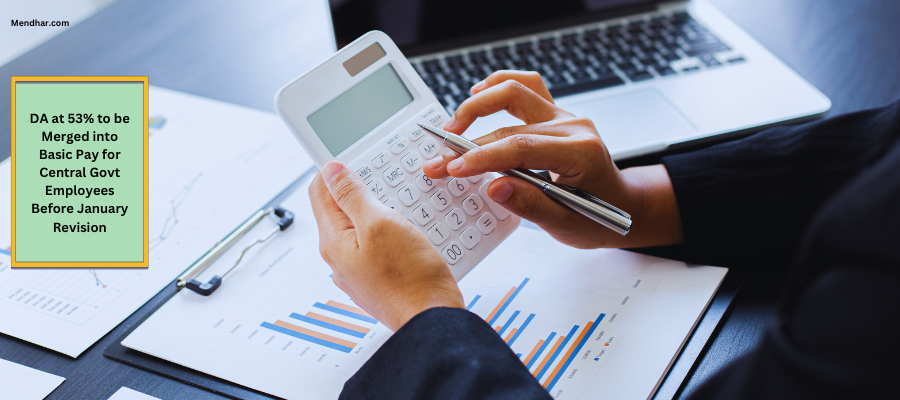Table of Contents
ToggleDA at 53% to be Merged into Basic Pay for Central Govt Employees Before January Revision

The Central Government’s decision to merge a 53% Dearness Allowance (DA) into the basic pay of employees, following the 7th Pay Commission guidelines, has sparked considerable interest. Expected to take effect before the January pay revision, this integration will likely increase employees’ monthly salaries, enhancing both in-hand earnings and retirement benefits. Here’s a closer look at the reasons behind this decision, details from the government circular, and the steps involved in implementing the change.
Why is DA Merging into Basic Pay?
To help employees counter inflation and maintain purchasing power, the government periodically raises DA. Once DA reaches a certain level—usually around 50%—it’s often merged into the basic pay to streamline salaries and provide enhanced long-term benefits.
Primary reasons for merging DA at 53% into basic pay include:
Impact on Allowances: Several allowances, such as House Rent Allowance (HRA) and Travel Allowance (TA), are calculated as a percentage of basic pay. By integrating DA into basic pay, these allowances increase automatically, providing additional financial benefits for employees.
Improved Retirement Benefits: Retirement benefits, including pension and gratuity, are determined based on basic pay. When basic pay rises due to DA merging, these benefits increase, ensuring employees have a stronger financial cushion post-retirement.
Simplified Pay Structure: Merging DA into basic pay simplifies salary structures, making pay calculations clearer and more straightforward.
Government Circular on DA Merger
The expected government circular will specify essential guidelines for this integration, including:
Eligibility: The circular will identify which central government employees, governed by the 7th Pay Commission, are eligible for the merger.
Effective Date: Although the merger is anticipated in January, the circular will confirm the official start date.
Additional Considerations: Clauses on arrears, tax adjustments, and possible exceptions may also be outlined in the circular.
Issued by the Ministry of Finance, this circular will be accessible on official government platforms such as the Department of Expenditure’s website.
How the DA Merging Process Works
The process of merging DA into basic pay follows guidelines set by the pay commission. Here’s a simplified overview:
Revised Basic Pay Calculation: The 53% DA is added to an employee’s current basic pay. For example, if an employee’s basic pay is INR 50,000, the DA amount to be merged would be 53% of this, or INR 26,500, making the revised basic pay INR 76,500.
Recalculation of Allowances: Allowances, such as HRA, that are based on a percentage of basic pay are then recalculated to reflect the updated basic pay.
Payroll Update and Arrears: Payroll systems are updated with the revised pay details, and if the merger is applied retroactively, arrears may be calculated and paid.
Financial Impact of DA Merger on Employees
The DA merger will increase not only the monthly take-home pay but also other long-term financial benefits for employees. With the boost to basic pay, retirement benefits, such as gratuity and pension, are also strengthened, providing additional financial security for central government employees.
The 7th Pay Commission recommends periodic DA mergers to align salaries with inflation and current economic conditions. Merging DA at the 53% threshold is consistent with previous measures taken at key levels, ensuring a balanced approach to salary adjustments.
Conclusion:-
The merger of 53% DA into the basic pay for central government employees represents both a financial enhancement and a morale-boosting measure. It demonstrates the government’s commitment to supporting employee welfare and shielding the workforce from inflation. With January approaching, employees should stay informed by reviewing official updates from the Ministry of Finance to understand how these adjustments may impact their monthly pay and long-term financial planning.

